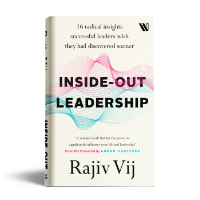In one of my first posts (Personal Mastery and the Journey Within), I had introduced the concept of personal mastery. In this blog, I would like to highlight the relevance of this concept to serving and building communities.
To me, personal mastery is the journey of self-discovery leading to consistently living the purpose of one’s life. It requires a high emphasis on self-knowledge, clarity of one’s personal vision and its interconnectedness with the people and the world around.
As the definition suggests, the person advanced in this journey is likely to have a deeper understanding of the interconnectedness of herself with the people and the world around her. Such a person is likely to well appreciate the interconnectedness of the different pieces that make up her world – elements of nature (the air she breathes and the water she drinks), efforts of people in her life (their love and support), contributions of her ancestors (in bringing her to life) and numerous other people in the world (whose efforts allow her to live her daily life with ease and comfort). As he acknowledges the contribution of others in his life and develops gratitude towards the people and the world around him, he is likely to feel obliged and become keener to pay the society back in some way or another.
Most often when we are unhappy, we have a starved feeling – a feeling of lack, as if we are not getting enough. As Shakti Gawain talks about the concept of outflowing in her book on Creative Visualization, she describes how when we find the place within us that is giving, the flow reverses. True giving, she clarifies, happens not from sacrifice, or self-righteousness or something spiritual, but from the pure joy of it. As we begin the journey within, we realize that we have an infinite reservoir of love and happiness within us; however, we are conditioned to thinking that we have to get something from the outside to be happy. As we learn to connect with our inner source of happiness and contentment, it automatically starts to outflow and we just begin to share more of it with others around us. And the more we share of ourselves from this wonderful position, the more we seem to get from the world and the universe. She also highlights that we can’t continue giving unless we are also open to receiving – giving also means giving to ourselves!
I believe a person on the journey of personal mastery would witness this powerful circle of giving and receiving quite effectively. Interestingly, some of the recent neuroscience research reinforces these concepts. As captured by Daniel Goleman in his book “Social Intelligence”, Philip Shaver of University of California has been studying the behavior patterns and attachment styles of adults with differing childhood experiences, and has broadly categorized them as secure, anxious, and avoidant. Simply put, happy, loving and caring childhood experiences result in secure adults. Anxious adults may have had anxious and pre-occupied parents. Emotionally distant parents likely result in children expecting others to be aloof and distant and hence more comfortable avoiding emotional intimacy – avoidant style. Mario Mikulincer, an Israeli research colleague of Philip Shaver, through elaborate experiments has demonstrated that each of these attachment styles has a distinct impact on the ability to empathize. One of the specific elements of behaviors he has assessed is the level of altruistic tendencies of these three attachment styles and has concluded that secure adults were the most empathetic and compassionate towards the needs of others. Anxious ones were seen overwhelmed by their own troubled reactions to others’ challenging needs and the avoidant ones were neither upset nor inclined to help, tending to suppress their emotions…unless they can see something in it for themselves.
The problem in our world today is not the lack of wealth or resources; it’s our lack of willingness and commitment to share them more broadly. My outlook is that people who are secure with themselves – through childhood experiences, or through other loving relationships in their lives, or through personal efforts to follow the journey of personal mastery – are highly likely to find meaning in giving and sharing with the community and the society beyond their own loved ones.
People Also Searched for:
community building /community development programme /community building activities











 Can’t Go Outside? Try Going Inside
Can’t Go Outside? Try Going Inside Needed In The Age of Artificial Intelligence: Real Wisdom
Needed In The Age of Artificial Intelligence: Real Wisdom Combating Our Inner Demons
Combating Our Inner Demons Personal Mastery and Parenting
Personal Mastery and Parenting Artha, Kama, Dharma, Moksha and The Sweet Spot of Life
Artha, Kama, Dharma, Moksha and The Sweet Spot of Life